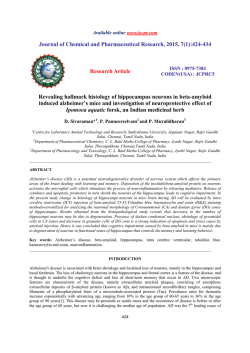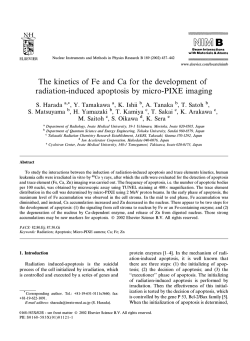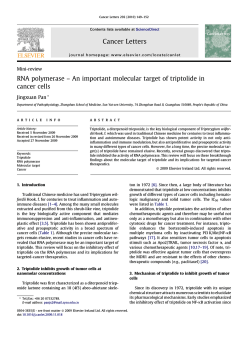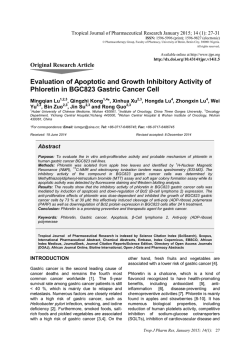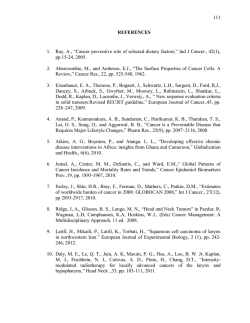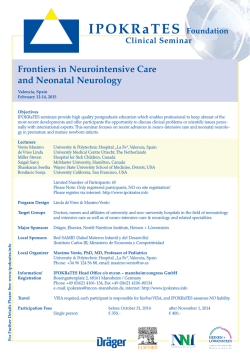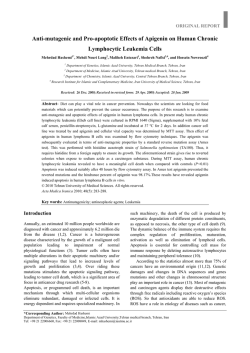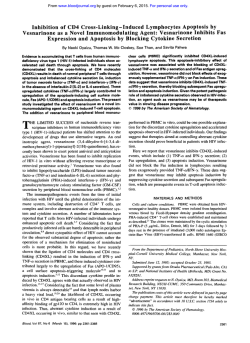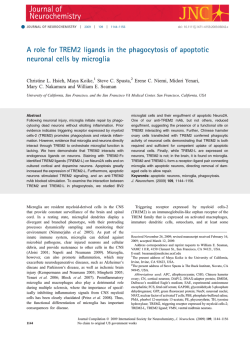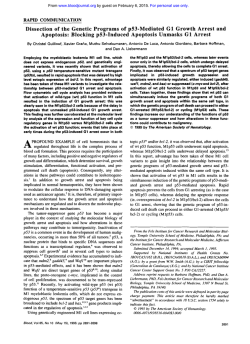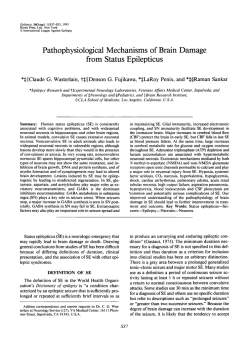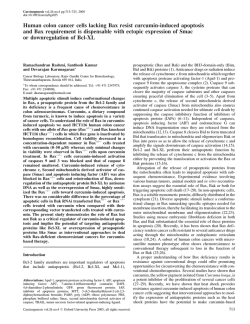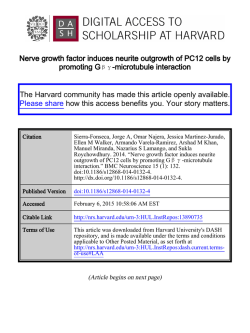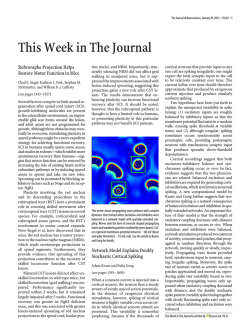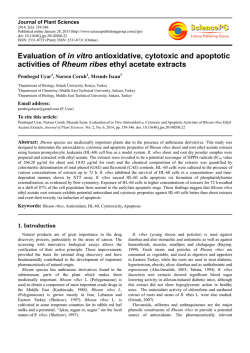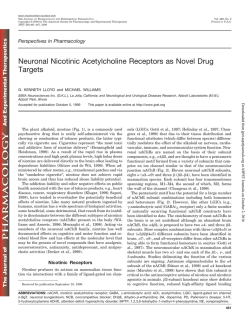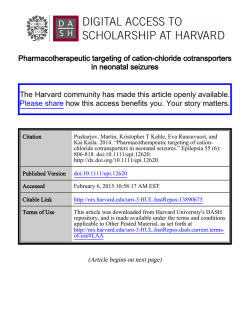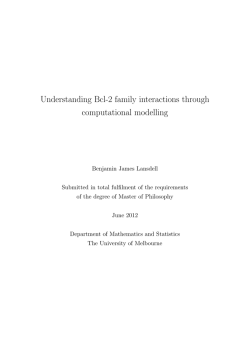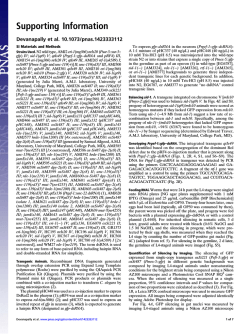
Delayed cell death in neonatal mouse
Neuroscience Letters 304 (2001) 165±168 www.elsevier.com/locate/neulet Delayed cell death in neonatal mouse hippocampus from hypoxiaischemia is neither apoptotic nor necrotic R. Ann Sheldon a, John J. Hall a, Linda J. Noble b, Donna M. Ferriero a,c,* a Neonatal Brain Disorders Laboratory, Department of Neurology, University of California San Francisco, San Francisco CA 94143, USA b Department of Neurosurgery, University of California San Francisco, San Francisco CA 94143, USA c Neonatal Brain Disorders Laboratory, Department of Pediatrics, University of California San Francisco, San Francisco CA 94143, USA Received 26 January 2001; received in revised form 23 March 2001; accepted 26 March 2001 Abstract Hypoxic-ischemic (HI) injury in neonatal mice is associated with signi®cant cell loss in hippocampus, striatum and deep layers of the cortex. The pattern of cell death in hippocampus after a moderate focal ischemic-global hypoxic insult is studied through morphologic changes in dying neurons at both the light and ultrastructural levels. Light microscopy at 24 h showed a number of injured neurons, as evidenced by dark, round, condensed nuclei, primarily in CA1 through CA3. Nuclei appeared punctate and cytoplasm vacuolated. Electron microscopy revealed that the punctate appearance of the nuclei corresponded to clumped chromatin. At 7 days after HI, injured neurons were shrunken and had a uniformly dark, angular appearance. While dying cells had an appearance consistent with apoptosis on light microscopy, cells were neither necrotic nor apoptotic at the ultrastructural level. q 2001 Elsevier Science Ireland Ltd. All rights reserved. Keywords: Neonate; Apoptosis; Necrosis; Injury; Hippocampus; Hypoxia-ischemia Cell death has been classi®ed as either necrotic or apoptotic depending on the type of stimulus [10]. Necrosis is characterized by swelling of the cell and its organelles with dissolution of the cell membrane, and apoptosis by shrinkage of the cell with preservation of the nuclear membrane and condensation of chromatin. The complex genetic, biochemical and molecular mechanisms involved in hypoxic-ischemic (HI) cell death make it likely that the characterization of such death as either necrosis or apoptosis may be implausible. Neuronal cell death is in¯uenced by the age of the animal, and the injury model employed, factors that result in a speci®c timing and pattern of brain damage [18]. The concepts of delayed neuronal death and regional vulnerability are central to the idea that some cells may be `rescued', or prevented from dying, after a HI injury. Selective neuronal vulnerability with delayed neuronal death has been found in adult models of ischemia [12], but has only recently been investigated in studies of HI in immature animals [8,9]. The type of cell death in the immature brain is still under intense investigation. Complemen* Corresponding author. University of California, San Francisco, Department of Neurology, P.O. Box 0114, San Francisco, CA 94143-0114, USA. Tel.: 11-415-502-5820; fax: 11-415-5025821. E-mail address: [email protected] (D.M. Ferrieroa). tary techniques for DNA fragmentation analysis (deoxynucleotidyl transferase-mediated UTP nick endlabeling (TUNEL) staining or DNA laddering) have shown selective vulnerability of the cortex and hippocampus in neonatal brain, but these methods are non-speci®c for the type of cell death [2]. Electron microscopic con®rmation of apoptosis has been reported for the immature dentate gyrus after bilateral HI [11], and areas remote from initial injury, like substantia nigra have shown this form of cell death (1). Newer methods using speci®c caspase pathway activation have shown apoptosis in immature rat brain as early as 6 h in the cortex after HI, and 12±18 h in striatum and hippocampus after a moderate insult, and prolonged activation up to 7 days in some regions [5,8,9]. Recently, it has been shown that delayed neuronal death varies with age and region; occurring 24 h following HI in rats as young as P13, predominately in CA2/CA3, but at P30 primarily in the cortex [15,18]. We have previously demonstrated that the hippocampus of the neonatal mouse exhibits regional vulnerability to HI [13]. In particular, neuronal injury is more evident in CA1-CA3 than in dentate gyrus. In all of the studies described above, various features consistent with apoptotic-like cell death were observed. However, none of these studies showed classical apoptosis like that observed as it was originally described in non- 0304-3940/01/$ - see front matter q 2001 Elsevier Science Ireland Ltd. All rights reserved. PII: S03 04 - 394 0( 0 1) 01 78 8- 8 166 R.A. Sheldon et al. / Neuroscience Letters 304 (2001) 165±168 neuronal cells [17]. The present study addresses the issue more directly by evaluating the morphologic features of cell death in a model of neonatal HI at 24 h and 7 days after HI at the light and electron microscopic levels. Postnatal day 7 (P7) CD1 mice (n 7) were subjected to HI (®ve at 24 h post-HI, two at 7 days post-HI) [6], and four animals served as non-surgical controls (two at P8, two at P14). Animals were anesthetized, the right common carotid artery was permanently ligated, and following a 2 h-recovery period with the dam, animals were exposed to 30 min of 8% humidi®ed oxygen with temperature maintenance at 36.58C. Animals were anesthetized 24 h or 7 days later with pentobarbital (50 mg/kg) and perfused with 2% glutaraldehyde, 2% paraformaldehyde, 0.5% dimethyl sulfoxide, 0.002% CaCl2 in 0.1 M sodium cacodylate, (pH 7.4). Brains were removed and post-®xed overnight and sectioned at 50 mm (for light microscopy) or 400 mm (for plastic embedding). Right and left hippocampi were excised from the 400 mm slices and immersed in 1% OsO4 for 2 h, rinsed in 0.1 M sodium cacodylate, dehydrated and embedded in Araldite. Hippocampi were trimmed to include CA1, CA3 or hilus prior to sectioning on an ultramicrotome. Semi-thin sections (0.5 mm) were obtained and stained with toluidine blue for light microscopic examination. Blocks were then retrimmed and thin sections (60 nm) were collected on copper grids, and reacted with uranyl acetate (2% in 70% ethanol) and lead citrate (9%) and viewed with an electron microscope. At 24 h after the HI insult, the CA1 region of the pyramidal cell layer of the hippocampus exhibited multiple cells with pronounced dark, round, condensed nuclei with fragmented, clumped chromatin (Fig. 1). The cytoplasm of these cells appeared intact at the light microscopic level. Fewer neurons in the CA3 region exhibited a similar appearance to those seen in CA1 (Fig. 1). Like CA3, the dentate gyrus exhibited little morphological change suggestive of cell injury at 24 h after HI. The contralateral hippocampus exhibited no morphological abnormalities. At 7 days after HI, cell damage was apparent in CA1, CA3 and to a lesser extent, in the dentate gyrus (Fig. 1). Injured neurons appeared as very dark, angular structures scattered through the pyramidal cell layers. The magnitude of cell death at this time appeared more pronounced in CA1 and CA3 when compared to the dentate gyrus. Fig. 1. CA1 region of right hippocampus (A,B) at 24 h (A) and 7 days (B) after HI. Note the injured cells at 24 h show dark, condensed nuclei (A, arrows) that correspond to irregular, punctate clumps of chromatin. CA3 (C,D) at 24 h (C) and 7 days (D) after HI exhibits fewer clusters of injured cells (C, arrows) as compared to CA1. At 7 days after HI, there are numerous clusters of darkly stained, irregularly shaped cells (B,D) in both regions. These cells are angulated, and exhibit both a darkly staining nucleoplasm and cytoplasm. Toluidine blue. Scale bar 10 mm. R.A. Sheldon et al. / Neuroscience Letters 304 (2001) 165±168 At the electron microscopic level (Fig. 2) there were no cells that exhibited a true apoptotic morphology with condensation of the cytoplasm and nuclear chromatin into membrane-bound apoptotic bodies [17]. At 24 h after HI, cells displayed a nucleus condensed into a rounded shape with numerous clumps of irregularly shaped chromatin. Organellar content of the cytoplasm was no longer obvious due to characteristic vacuolization of the cytoplasm of these cells (Fig. 2). These ultrastructural ®ndings were most apparent in CA1 and CA3. Despite the relative resistance of the hilar region to injury, more cells exhibited these changes by 7 days after HI. No cells were seen undergoing developmental programmed cell death in the hippocampus at the ages examined. While this form of apoptotic cell death is still occurring in some regions of the brain in early postnatal life, none was observed in the hippocampus. We have shown that neuronal cell loss in the hippocampus due to neonatal HI is selective to certain regions, and Fig. 2. CA3 pyramidal cell at 24 h after H-I (A). The nuclear and cytoplasmic membranes are no longer clearly distinguishable. Dentate granule cell at 7 days after H-I (B). The cell is dark and characteristically angular in appearance. The cytoplasm exhibits swollen mitochondria and disrupted cristae, and the golgi apparatus is damaged. Scale bar 75 nm. 167 progressive over time, and does not exhibit classic features of apoptosis. At 24 h after HI, dead or dying cells typically exhibited a condensed nucleus and clumping of chromatin, features described as being apoptotic [5,8]. However, additional ultrastructural analysis demonstrated that these cells were not classically apoptotic, since the cytoplasm was severely vacuolated and undergoing dissolution. In addition, the nucleolus remained distinct, whereas in apoptosis there is early disassembly of the nucleolus [17]. Darkened cytoplasm, such as that seen with light microscopy at 7 days after HI, is generally thought to be an indication of apoptosis as the cell condenses [17]. These cells have uniformly dark cytoplasm, but form irregular, angular shapes, rather than apoptotic bodies. There is also swelling and degeneration of organelles, but the cells are not undergoing the karyolysis that is typical of necrosis. This process has alternatively been described as the `apoptotic-necrotic continuum' [7] or as `paraptosis' [14]. Different patterns of cell death have been reported, which may depend, in part, on the method used. Methodology has been a source of debate, and there is not yet a de®nitive method for determining type of cell death with the possible exception of electron microscopy (EM). In cultures of cerebellar granule cells exposed to glutamate, for example, early necrosis is followed by delayed apoptosis of cells that initially survive [1]. This pattern is attributed to early failure, and then recovery, of mitochondrial membrane potential. The P7 rat model of HI has been shown to produce TUNEL positive cells with DNA fragmented nuclei in areas with several different types of cell death by morphology, indicative of non-speci®c TUNEL staining [3]. Others have shown, however, that karyorrhectic nuclei that result from pyknosis and is a hallmark of necrosis, are dif®cult to distinguish from apoptotic bodies, and therefore may indicate a greater role for apoptosis [16]. Beilharz et al., using a 21-day-old rat model of HIE, showed apoptotic morphology with a mild insult (15 min of hypoxia) but necrotic morphology with a severe insult (60 min of hypoxia) [8]. In a model of bilateral HI with hypoglycemia in P7±P10 rats, immature hippocampal dentate granule cells were found to be injured 2±3 days after the insult with EM ®ndings similar to those reported here [4]. The de®nition of apoptosis may need to be changed in injury models, abandoning the term altogether in favor of a broader description of cell death. Having seen cells by EM that portray neither a classically apoptotic nor necrotic morphology, but rather aspects of both, Martin et al. have proposed the use of the concept of a continuum from apoptosis (early injury) to necrosis [7]. Since we did not see any clearly apoptotic cells, but did see some like those described that bridge the de®nition of apoptotic and necrotic, this description seems attractive. Others would most likely refer to these cells as `secondarily' necrotic (18). This implies that excitotoxic cell death may occur side by side with cells undergoing apoptotic cell death, and that those dying in a necrotic fashion may induce apoptosis in others, 168 R.A. Sheldon et al. / Neuroscience Letters 304 (2001) 165±168 which raises the question of the mechanism of delayed neuronal death. The particular pathways of cell death after HI have yet to be determined [7], but it is believed that ªrescuingº these cells may have clinical relevance. For clinical relevance, however, we need to come to a consensus on a de®nition of the appearance of a potentially `salvagable' cell. While necrotic cell death and apoptosis are unique forms of cell death, alternate pathways may exist that might be under separate genetic control. This study lends support to the view that other pathways do exist, and that further work is needed to dissect the molecular underpinnings. This work was supported by grants NIH RO1NS33997 and P50NS35902. [1] Ankarcrona, M., Dypbukt, J.M., Bonfoco, E., Zhivotovsky, B., Orrenius, S., Lipton, S.A. and Nicotera, P., Glutamateinduced neuronal death: a succession of necrosis or apoptosis depending on mitochondrial function, Neuron, 15 (1995) 961±973. [2] Beilharz, E.J., Williams, C.E., Dragunow, M., Sirimanne, E.S. and Gluckman, P.D., Mechanisms of delayed cell death following hypoxic-ischemic injury in the immature rat: evidence for apoptosis during selective neuronal loss, Brain Res. Mol. Brain Res., 29 (1995) 1±14. [3] de Torres, C., Munell, F., Ferrer, I., ReventoÂs, J. and Macaya, A., Identi®cation of necrotic cell death by the TUNEL assay in the hypoxic-ischemic neonatal rat brain, Neurosci. Lett., 230 (1997) 1±4. [4] Goodman, J.H., Wasterlain, C.G., Massarweh, W.F., Dean, E., Sollas, A.L. and Sloviter, R.S., Calbindin-D28k immunoreactivity and selective vulnerability to ischemia in the dentate gyrus of the developing rat, Brain Res., 606 (1993) 309±314. [5] Han, B.H., D'Costa, A., Back, S.A., Parsadanian, M., Patel, S., Shah, A.R., Gidday, J.M., Srinivasan, A., Deshmukh, M. and Holtzman, D.M., BDNF blocks caspase-3 activation in neonatal hypoxia-ischemia, Neurobiol. Dis., 7 (2000) 38± 53. [6] Ishimaru, M.J., Ikonomidou, C., Tenkova, T.I., Der, T.C., Dikranian, K., Sesma, M.A. and Olney, J.W., Distinguishing excitotoxic from apoptotic neurodegeneration in the developing rat brain, J. Comp. Neurol., 408 (1999) 461±476. [7] Martin, L.J., Al-Abdulla, N.A., Brambrink, A.M., Kirsch, J.R., Sieber, F.E. and Portera-Cailliau, C., Neurodegeneration in excitotoxicity, global cerebral ischemia, and target deprivation: A perspective on the contributions of apoptosis and necrosis, Brain Res. Bull., 46 (1998) 281±309. [8] Nakajima, W., Ishida, A., Lange, M.S., Gabrielson, K.L., Wilson, M.A., Martin, L.J., Blue, M.E. and Johnston, M.V., Apoptosis has a prolonged role in the neurodegeneration after hypoxic ischemia in the newborn Rat, J. Neurosci., 20 (2000) 7994±8004. [9] Northington, F.J., Ferriero, D.M., Graham, E., Traystman, R.J. and Martin, L.J., Early neurodegeneration after hypoxia-ischemia in neonatal rat is necrosis while delayed neuronal death is apoptosis, Neurobiol. Dis., 8(2) (2001) 207±219. [10] Oo, T.F., Henchcliffe, C. and Burke, R.E., Apoptosis in substantia nigra following developmental hypoxicischemic injury, Neuroscience, 69 (1995) 893±901. [11] Pulera, M.R., Adams, L.M., Liu, H., Santos, D.G., Nishimura, R.N., Yang, F., Cole, G.M. and Wasterlain, C.G., Apoptosis in a neonatal rat model of cerebral hypoxia-ischemia [see comments], Stroke, 29 (1998) 2622±2630. [12] Pulsinelli, W.A., Brierley, J.B. and Plum, F., Temporal pro®le of neuronal damage in a model of transient forebrain ischemia, Ann. Neurol., 11 (1982) 491±498. [13] Sheldon, R.A., Sedik, C. and Ferriero, D.M., Strain-related brain injury in neonatal mice subjected to hypoxia-ischemia, Brain Res, 810 (1998) 114±122. [14] Sperandio, S., deBelle, I. and Bredesen, D.E., An alternative, nonapoptotic form of programmed cell death, Proc. Natl. Acad. Sci. USA, 97 (2000) 14376±14381. [15] Tow®ghi, J. and Mauger, D., Temporal evolution of neuronal changes in cerebral hypoxia-ischemia in developing rats: a quantitative light microscopic study, Brain Res. Dev. Brain Res., 109 (1998) 169±177. [16] van Lookeren Campagne, M., Lucassen, P.J., Vermeulen, J.P. and BalaÂzs, R., NMDA and kainate induce internucleosomal DNA cleavage associated with both apoptotic and necrotic cell death in the neonatal rat brain, Eur. J. Neurosci., 7 (1995) 1627±1640. [17] Wyllie, A.H., Kerr, J.F. and Currie, A.R., Cell death: the signi®cance of apoptosis, Int. Rev. Cytol., 68 (1980) 251± 306. [18] Yager, J.Y. and Asselin, J., The effect of pre hypoxicischemic (HI) hypo and hyperthermia on brain damage in the immature rat, Brain Res. Dev. Brain Res., 117 (1999) 139±143.
© Copyright 2025
